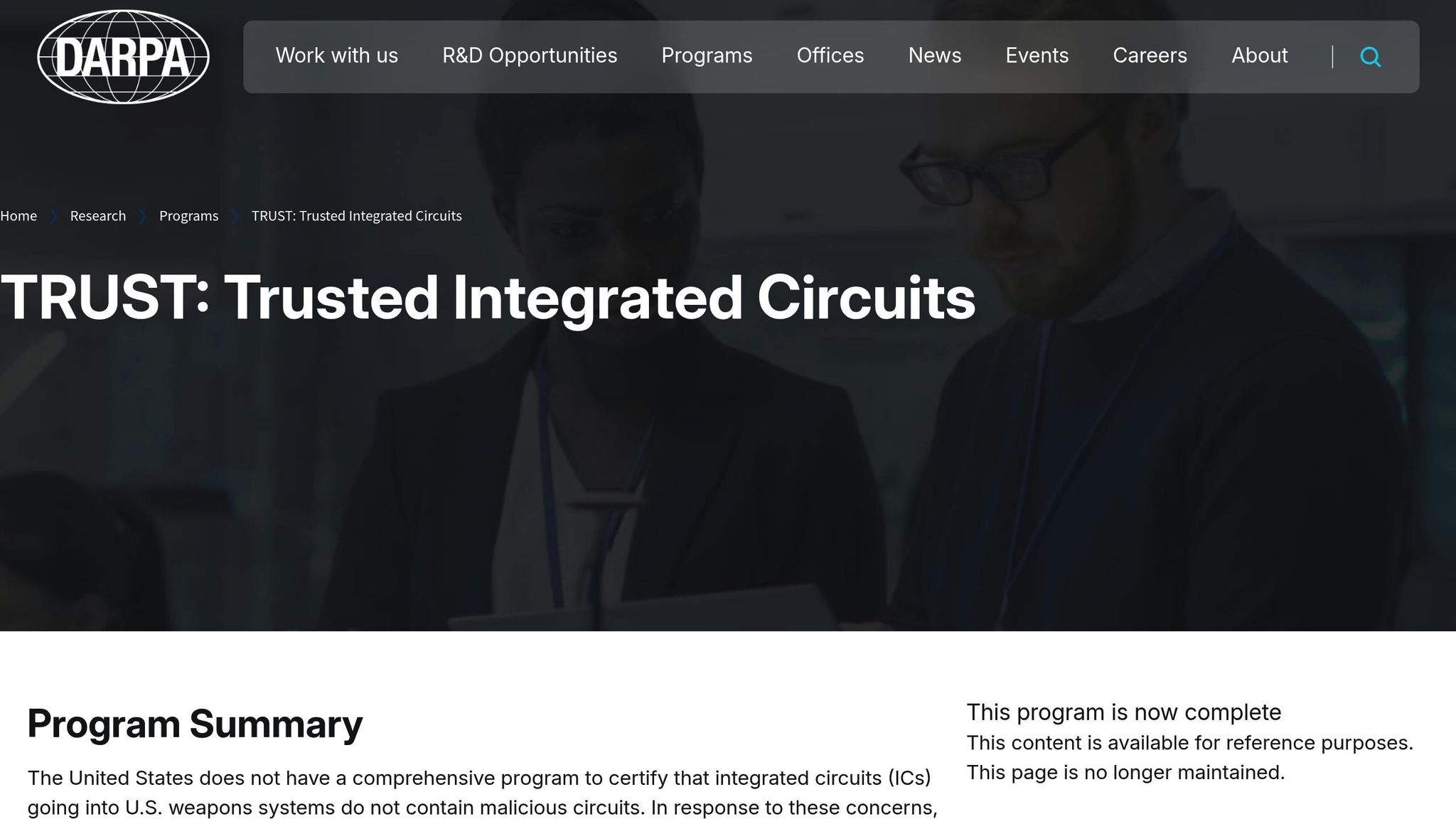UT Austin is driving semiconductor innovation through partnerships with Emerson, Samsung, and DARPA. These collaborations focus on cutting-edge research, workforce training, and boosting Austin’s economy. Here’s a quick overview:
- Emerson: Automating semiconductor production, improving quality, and reducing energy use.
- Samsung: Advancing materials, AI-driven manufacturing, and sustainable production.
- DARPA: Enhancing computing architectures, materials, and cybersecurity in manufacturing.
These initiatives are creating jobs, upgrading facilities, and positioning Austin as a key semiconductor hub. However, challenges like lab space, funding, and balancing academic and industry goals remain.
Emerson pledges $8.5M to UT Austin for AI, semiconductor …
1. Emerson and UT Austin
Emerson has teamed up with UT Austin to advance semiconductor technology and workforce training. By investing in the Cockrell School of Engineering, Emerson is supporting research in process control, quality improvements, and energy-efficient manufacturing. Here’s a closer look at the collaboration.
Research Areas and Investment
The partnership focuses on three main research areas:
- Advanced Process Control: Automating semiconductor fabrication processes.
- Quality Improvements: Using real-time monitoring to detect and reduce defects.
- Energy Efficiency: Developing methods to lower energy use in manufacturing.
Job Creation and Workforce Training
This collaboration goes beyond research. It creates jobs and offers hands-on training opportunities designed to bridge the skills gap in the semiconductor industry. Students and researchers gain practical experience, preparing them for real-world challenges in this field.
Facilities and Industry Collaboration
Emerson has built cutting-edge labs and collaborative spaces at UT Austin. These facilities provide a place for students and researchers to experiment and learn while sharing knowledge with local manufacturers. This partnership strengthens Austin’s position in semiconductor manufacturing and reinforces its role as a hub for microelectronics innovation.
2. Samsung Research Program
Samsung has teamed up with UT Austin to push forward semiconductor research and development while strengthening the local semiconductor industry.
Research Focus Areas
The program targets several important areas:
- Advanced Materials Development: Investigating new semiconductor materials and how they can be integrated into modern manufacturing processes.
- AI-Driven Manufacturing: Leveraging artificial intelligence to improve efficiency and product quality.
- Sustainable Production: Creating methods to reduce environmental impact during semiconductor manufacturing.
These research goals are supported by significant investments on campus.
Investment and Infrastructure
Samsung is enhancing UT Austin’s campus infrastructure to align with its research priorities. This includes funding advanced research facilities, such as specialized laboratories outfitted with cutting-edge testing and simulation tools.
Workforce Development Initiatives
The program also focuses on bridging academic research with industry demands. Internship and training opportunities are designed to prepare students with the skills needed in the semiconductor field.
Economic Impact
This partnership boosts Austin’s semiconductor industry by driving innovation and opening up opportunities for students, researchers, and the community as a whole.
sbb-itb-4c99469
3. DARPA TIE Program
UT Austin has joined forces with DARPA’s TIE program to push the boundaries of semiconductor research and manufacturing. Building on earlier successes with Emerson and Samsung, this partnership aims to boost the development of cutting-edge microelectronics in the Austin tech hub. By combining academic, industry, and defense expertise, the program focuses on advancing research, fostering collaboration, and accelerating practical applications.
Research Focus
The TIE program zeroes in on three main areas:
- Developing advanced computing architectures for new and emerging applications.
- Investigating innovative materials and designs that bridge traditional and next-generation computing.
- Strengthening cybersecurity measures in semiconductor manufacturing.
Collaborative Framework
This initiative brings together multiple layers of expertise:
- Faculty and students from UT Austin contribute research and innovation.
- Local semiconductor companies provide industry knowledge and resources.
- DARPA ensures alignment with national priorities through strategic oversight.
Infrastructure and Technology Transfer
The program makes the most of existing research facilities and focuses on quickly turning lab breakthroughs into real-world applications. This approach not only enhances technology transfer but also provides specialized workforce training. It bolsters UT Austin’s role in semiconductor advancements while addressing national security needs in microelectronics.
Partnership Results and Limitations
UT Austin’s semiconductor partnerships have led to notable progress but come with their own set of challenges.
Challenges Across Partnerships
Each partnership has its own approach, leading to both advancements and roadblocks:
- Emerson Partnership: Focuses on industrial automation. While effective for its niche, this limits the potential for broader technology applications.
- Samsung Collaboration: Faces hurdles with intellectual property issues and delays in bringing innovations to market.
- DARPA TIE Program: Has made strides in cybersecurity and interdisciplinary research. However, strict security protocols and approval processes slow down commercial adoption.
Operational Outcomes and Constraints
Resource investments have strengthened core capabilities but introduced some limitations. Technology transfer speeds vary widely – some partnerships achieve quick results, while others get bogged down by regulations. Workforce training and infrastructure upgrades show mixed results; some programs have significantly improved facilities, while others remain narrowly focused. Economically, certain partnerships have boosted Austin’s semiconductor industry, but defense-focused collaborations have had less impact on commercial markets. These outcomes provide key insights into challenges for scaling up in the future.
Key Challenges for Future Growth
Scaling these partnerships will require tackling several issues:
- Insufficient lab space and changing workforce needs
- Balancing academic goals with industry priorities
- Uncertainty around long-term funding
These challenges underscore the delicate balance between research, industry demands, and regulatory frameworks. Overcoming them will be critical for achieving sustainable growth and broader market influence.
Summary and Impact
UT Austin’s semiconductor partnerships have played a key role in strengthening Austin’s tech landscape and advancing U.S. manufacturing. Collaborations with companies like Emerson, Samsung, and DARPA have established the region as a major center for semiconductor development and production.
These partnerships have also helped train a skilled workforce. For example, Samsung’s program has prepared graduate students who are now contributing to local manufacturing efforts, addressing the growing demand for talent in the chip industry.
The results are clear: Emerson’s automation solutions improve manufacturing efficiency, DARPA’s initiatives enhance semiconductor cybersecurity, and Samsung’s research has led to new production patents. Together, these efforts are pushing the boundaries of what’s possible in semiconductor technology.
Beyond technology, the impact extends to the local economy. New businesses and real estate developments are springing up around these facilities, solidifying Austin’s reputation as a semiconductor hub. For those curious about how this economic growth is shaping local property markets, the Austin Local Team provides insights into emerging real estate trends.
These accomplishments position UT Austin to continue advancing U.S. semiconductor production. Its research programs and industry partnerships are driving progress and supporting national efforts to reduce reliance on foreign chip suppliers.








